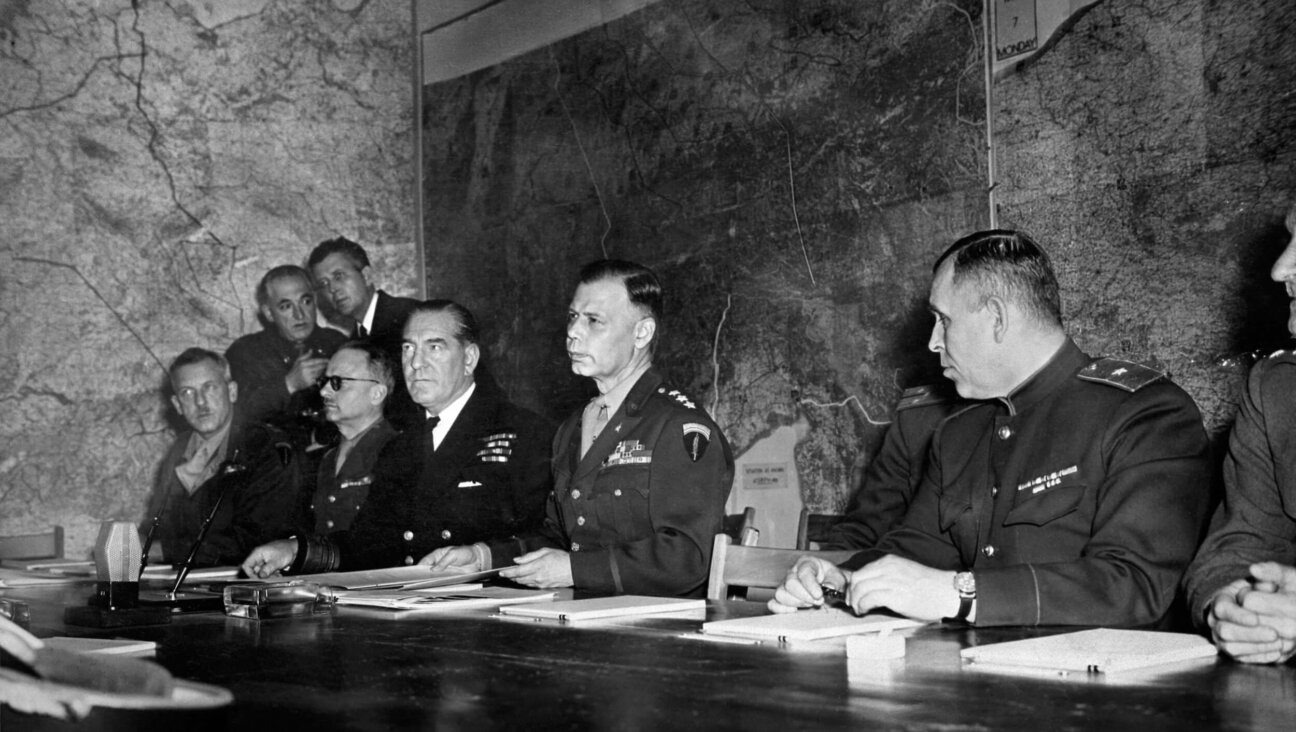March of the Living Exploits — Like 9/11 Museum

March of the Living participants visit Auschwitz in 2009 / Yossi Selliger
This year, I made the difficult decision not to join my high school classmates on March of the Living, an organized trip that takes students to Poland’s death camps and then on to Israel. But it wasn’t until I read Meg Bloom Glasser’s opinion piece, which laments the new 9/11 Museum’s approach to memorializing, that I fully understood why.
The word Bloom Glasser uses is “spectacle.”
“I have been reduced to a spectator in the cheap seats,” she said, convinced that the new Manhattan museum has filched from her any and all control over the memory of her husband, who died in the attacks.
“Spectacle” is just the right word for March of the Living. The most recognizable features in a March of the Living photo are the locked arms, the bright matching caps and shirts, and, most prominently, the Israeli flags — all decked out, right on the train tracks into Auschwitz.
The in-your-face, Israeli-flag-waving flashiness at the camps is disquieting because it represents Israel — in a seemingly innocent way — as a beacon of perfection in the Jewish world, and as something that is in need of everyone’s protection at all times. The hidebound nationalism is a bit much.
But Bloom Glasser captures my disillusionment through a sharper lens. “[9/11] may have been a public loss” — the Holocaust, too, is one of the most mourned public losses — “but… rather than honoring the lives lost, the museum just seems to exploit those deaths to tell a bigger story.”
On March of the Living, that bigger story starts at the camps and continues with the State of Israel. And that’s precisely how the trip is purposely designed. My classmates described it as “surreal”: one moment they envisioned the death of millions in the gas chambers, the next moment, wow, Jews have access to the Kotel. One friend even marveled at being able to walk freely into an Aroma coffee shop.
Bloom Glasser also describes the 9/11 Museum’s opening ceremonies as a “reenactment.” That is a subjective impression. But at March of the Living, it is a clear institutional goal. The very name “March of the Living,” which refers to the three-kilometer walk participants take — again, with fanfare — from Auschwitz to Birkenau, “is designed to contrast with the death marches,” and “serves as a hopeful counterpoint to the experience of hundreds of thousands of Jews,” according to the March of the Living website’s “About” page. To my mind, a humble visit to the train tracks, gas chambers and crematoria should suffice, without the histrionics.
One classmate of mine not only emphasized a newfound desire to protect Israel after the trip, but actually said, “Not until I got to Israel did I really understand how meaningful [Poland] was.”
That’s a problem.
The intense emotional swell experienced when going from a concentration camp to a beautiful Israel that “thrives so effortlessly,” as the same friend put it, is understandable. After all, the trip is designed to provoke exactly that reaction. And it’s a justifiable feeling to have, even when not on an organized trip.
But this approach, like that favored by the 9/11 Museum, detracts from the goal of memorializing the dead. On March of the Living, the dead are remembered and revered, as they should be. But they are remembered only as part of a larger narrative — that of Jewish pride and resilience — not for their own sakes or their own stories.
What’s missing in both places — the Museum and the March — is a profound, personal and distinct respect for the lives themselves, for the people that are no longer. In their fanfare and pageantry, both memorials abandon that personal connection in the very places where it should prevail.
The Forward is free to read, but it isn’t free to produce

I hope you appreciated this article. Before you go, I’d like to ask you to please support the Forward.
Now more than ever, American Jews need independent news they can trust, with reporting driven by truth, not ideology. We serve you, not any ideological agenda.
At a time when other newsrooms are closing or cutting back, the Forward has removed its paywall and invested additional resources to report on the ground from Israel and around the U.S. on the impact of the war, rising antisemitism and polarized discourse.
This is a great time to support independent Jewish journalism you rely on. Make a gift today!
— Rachel Fishman Feddersen, Publisher and CEO
Support our mission to tell the Jewish story fully and fairly.
Most Popular
- 1

Culture Cardinals are Catholic, not Jewish — so why do they all wear yarmulkes?
- 2

Fast Forward Ye debuts ‘Heil Hitler’ music video that includes a sample of a Hitler speech
- 3

News School Israel trip turns ‘terrifying’ for LA students attacked by Israeli teens
- 4

Fast Forward Student suspended for ‘F— the Jews’ video defends himself on antisemitic podcast
In Case You Missed It
-

Yiddish קאָנצערט לכּבֿוד דעם ייִדישן שרײַבער און רעדאַקטאָר באָריס סאַנדלערConcert honoring Yiddish writer and editor Boris Sandler
דער בעל־שׂימחה האָט יאָרן לאַנג געדינט ווי דער רעדאַקטאָר פֿונעם ייִדישן פֿאָרווערטס.
-

Fast Forward Trump’s new pick for surgeon general blames the Nazis for pesticides on our food
-

Fast Forward Jewish feud over Trump escalates with open letter in The New York Times
-

Fast Forward First American pope, Leo XIV, studied under a leader in Jewish-Catholic relations
-
Shop the Forward Store
100% of profits support our journalism
Republish This Story
Please read before republishing
We’re happy to make this story available to republish for free, unless it originated with JTA, Haaretz or another publication (as indicated on the article) and as long as you follow our guidelines.
You must comply with the following:
- Credit the Forward
- Retain our pixel
- Preserve our canonical link in Google search
- Add a noindex tag in Google search
See our full guidelines for more information, and this guide for detail about canonical URLs.
To republish, copy the HTML by clicking on the yellow button to the right; it includes our tracking pixel, all paragraph styles and hyperlinks, the author byline and credit to the Forward. It does not include images; to avoid copyright violations, you must add them manually, following our guidelines. Please email us at [email protected], subject line “republish,” with any questions or to let us know what stories you’re picking up.















